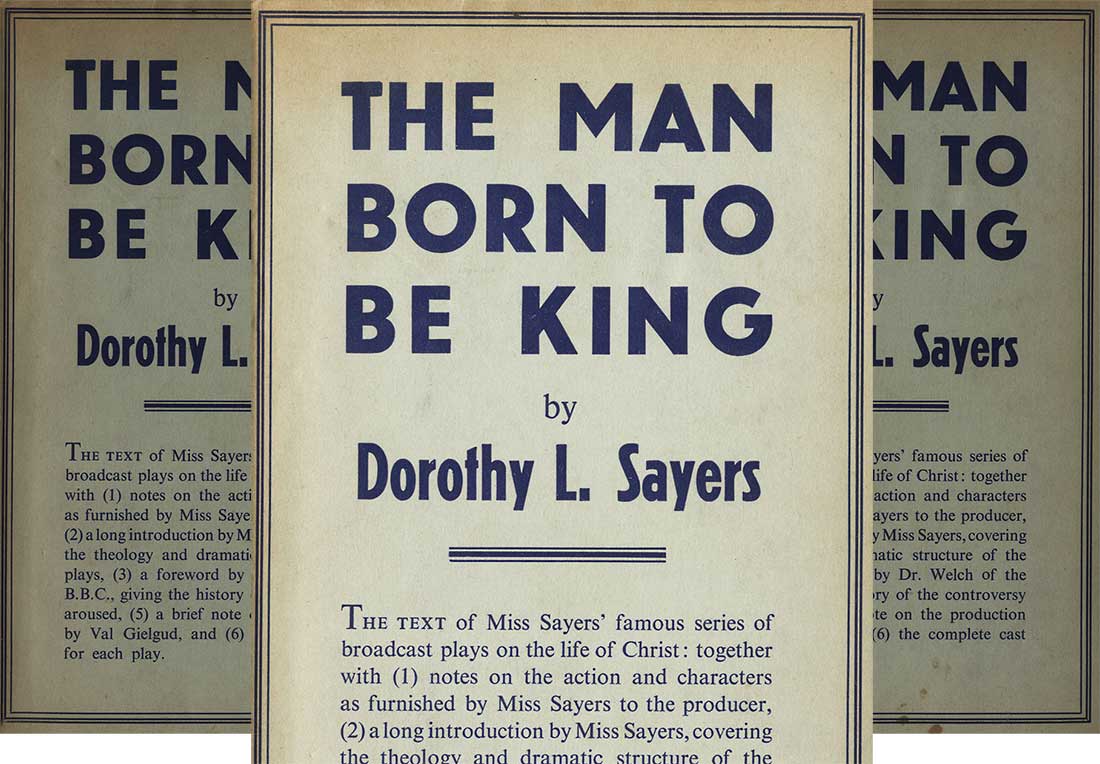Veiw
The Greatest Drama Ever
Gilbert Meilaender on Reading Dorothy Sayers's Play Cycle for Lent
On June 4, 1955, C. S. Lewis wrote to Dorothy Sayers to thank her for a pamphlet and letter she had sent him. He noted, in passing, that "as always in Holy Week," he had been "re-reading [Sayers's] The Man Born to Be King. It stands up to this v. particular kind of test extremely well." We might, I think, do far worse than imitate Lewis in our own Lenten reading.
The Man Born to Be King is a series of radio plays, twelve in all, dramatizing the life of Jesus from birth to death and resurrection. First broadcast by the BBC in 1941–1942, they were published in 1943, together with Sayers's notes for each play and a long Introduction she wrote recounting both her aims and approaches in writing the plays and some of the first (often comical) reactions from the public.
Sayers did not suffer fools gladly, and she takes evident delight in recounting objections, many of which grew out of a kind of piety that resisted the deliberate realism of the plays. Thus, for example, among those who wrote her with objections was one who objected to her having Herod tell his court, "Keep your mouths shut." The reason for the objection? Such "coarse expressions" struck the correspondent as "jarring on the lips of any one 'so closely connected with our Lord.'"
Of course, some of the objections can be better understood and may seem less comical if we note how much has changed since the plays were first broadcast roughly three-quarters of a century ago. Sayers notes in her Introduction that British law at the time prohibited "the representation on the stage of any Person of the Holy Trinity"—and this, in turn, encouraged listeners to think of Jesus in ways that could scarcely do justice to his genuine humanity. Therefore, while observing within Christian sacred art "a dialectic" that emphasizes sometimes the incarnation of the eternal Word in Jesus, and other times the "scandal of particularity" in Jesus the first-century Jew, her plays tilt in the latter direction, toward a kind of realistic narrative. Jesus is, quite simply, the man born to be king.

There were, though, other difficulties confronting her that have not changed much over time. For the British public at the time she wrote—but also, in many cases, for us today—the Gospels were known chiefly "as a collection of disjointed texts and moral aphorisms wrenched from their contexts." This is, after all, the way we read them Sunday after Sunday. There is nothing wrong with doing so; indeed, there is much that is right about it. Still, it creates problems for the dramatist who aims to produce a story that is coherent in its overall trajectory and in its several episodes.
A Coherent & Arresting Telling
That is where the artist's skill and imaginative powers are essential, and, to my mind at least, Sayers is at the top of her form in these plays. Those who know her other writings will recall how insistently she argued that her task was to produce—as best she could—good work, plays that were truly good art. The theology implicit in the story and the religious impact of the events recounted would, she hoped, emerge from the story told, but her task was simply to tell that story in as coherent and arresting a fashion as possible. She had to develop the story through characters who, unlike us, do not know how it will end, and who could not, therefore, think in ways that might seem natural to us.
The plays may, therefore, call for some imaginative stretching on our part, but that stretching may also offer in turn a considerable theological payoff. In particular, it may keep Christians from a mistake they have often made—supposing that the political and religious leaders responsible for Jesus' death had as their aim "doing away with God." That is not how Sayers tells the story. "We, the audience, know what they were doing; the whole point and poignancy of the tragedy is lost unless we realise that they did not."
Imaginative Readings
Sayers unfolds the story in twelve separate plays. (She notes in her Introduction a difficulty facing the writer of such a series of radio plays. The plays were broadcast on Sunday evenings, at intervals of four weeks. Some listeners would hear all the plays, but many would not. Hence, each play had to fit into the larger story while, simultaneously, having its own artistic unity.) Following by and large the chronology of the Gospel of John (though she makes the Last Supper a Passover meal), her story moves from "Kings in Judea," which tells of Jesus' birth, to Jesus' post-Resurrection appearances in "The King Comes to His Own."
Attempting to tell the story in a way that recognizes both Jesus' humanity and the place and time in which he lived, Sayers takes the miracles seriously while also sometimes "making sense" of them in imaginative ways. The Jesus of the plays does not foresee with certainty or in detail what all the other characters will do, nor is he stage-managing events.
Thus, for example, Sayers discerns "a major puzzle" in the story of Jesus' entry into Jerusalem on Palm Sunday. It is "the mysterious readiness of the 'ass's colt,'" near at hand to fulfill prophecy. In her eighth play ("Royal Progress") she tells the story in a way that accounts for the readiness. Events are not magically arranged by Jesus in order to fulfill prophecy, for "the fulfilment of a prophecy isn't a fulfilment if somebody does it on purpose." Instead, in Jesus' instructions to his disciples he uses a password provided by another character, Baruch the Zealot—and uses it in a way that signals (to Baruch's disappointment) that his intentions are not violent.
Among the most striking of Sayers's imaginative readings is the way the exchange between Jesus and the two thieves crucified with him unfolds. Gestas joins in the mockery of Jesus, but Dysmas does what he can to comfort Jesus. Believing that Jesus must be "looney" to think himself "Goddamighty," he plays along, trying to make Jesus feel better. "You're all right, mate, ain't you? Of course you are. This ere's just a bad dream. One o' these days you'll come out in a cloud of glory and astonish 'em all. . . ." Gestas scoffs at such nonsense; but, "in a deeply respectful tone, humoring this harmless lunacy" (as Sayers's stage directions put it), Dysmas says to Jesus: "Sir, you'll remember me, won't you, when you come into your kingdom?" To which Jesus makes his well-known response, which we generally think of simply as his second word from the Cross. Different readers (or, originally, listeners) may respond differently to this way of understanding the thief's request. But it has an imaginative sensibleness that brings us up short and opens up new meanings in the story.
Sayers's Tie-Rods
I noted earlier the difficulty Sayers faced, needing to make each play a self-contained narrative while still giving coherence to the whole. Her response was to look for ways to make connections within the story, in order to tie the twelve plays together. Thus, the Roman centurion at the Cross (whom she names Proclus) is identified with the centurion whose servant was healed. And a much younger Proclus is involved in the story even earlier, when the Magi come after Jesus' birth. Similarly, Pilate's wife is written into the story early by the simple device of having her see Jesus at the Feast of the Tabernacles, and by having the processions of Pilate and Jesus meet at the gates of Jerusalem on Palm Sunday. The nobleman whose son was healed is placed earlier as a guest at the wedding in Cana. Mary Cleophas (the mother of James and John) is also identified near the end of the story as the second of the disciples on the road to Emmaus.
Perhaps the most important "tie-rod" (Sayers's term) running through the entire cycle of plays is the character of Judas. He is present near the beginning as a disciple of John the Baptist, and the theme that runs throughout ("the nature of earthly and spiritual kingdoms") is moved along primarily through his character. Judas is, of course, a figure who endlessly intrigues, mystifies, and horrifies. Sayers notes that various people wrote angrily to her, complaining that "the Judas I have depicted seems to them to be a person of the utmost nobility, actuated by extremely worthy motives." That is, in a way, true.
For Sayers, "one thing is certain." Judas "cannot have been the creeping, crawling, patently worthless villain" that some have imagined. She depicts—it is only an artist's guess—his peculiar temptation as "an intellectual devil of a very insidious kind." That is to say, she does not deny his seeming nobility of purpose.
Her Judas is drawn to Jesus because he believes—and believes, at least at first, that Jesus also believes—in the path of self-sacrifice. Gradually, however, coming to fear that Jesus actually wants to be a political deliverer who will not take the path of suffering, Judas turns against him. In his intellectual pride he cannot trust that anyone else could see what is needed as clearly as he himself sees it. Hence, he decides to force upon Jesus the way of suffering. Sayers accomplishes this in the plays' plot structure by having Judas and the Zealot Baruch ("the one character of any importance who is of my own invention") conspire together to try to determine Jesus' intentions. But Judas cannot understand, because finally he will not understand, the course Jesus takes. His was "the besetting sin of highly virtuous and intelligent people."
Regaining the Sting
The Man Born to Be King remains lively, imaginative, and also deeply devotional yet today. It can, I think, still stand up to the test of being read in Holy Week, as it did for Lewis. But for readers today, there will be a few problems that must simply be faced. They crop up more in Sayers's notes to the plays than in the plays themselves. At one point in her explanatory notes she uses the "N-word." To be sure, she uses it not as an expression of her own view but simply to describe how a Roman soldier at that time would have thought about the natives where he was stationed. Even so, we know how difficult it is to offer such explanations in our cultural context.
More troubling is a kind of reflexive anti-Semitic comment in the notes (quite characteristic perhaps of Sayers's own time and place) when she writes of Matthew, the tax collector who became a disciple of Jesus, that he is "as vulgar a little commercial Jew as ever walked White-chapel, and I should play him with a frank Cockney accent." We need not doubt that Matthew's character was scorned by many of his fellow Jews from whom he collected taxes, but there is nothing to be done about a sentence such as this other than note and regret it.
At her best, however, Sayers sees more deeply into the complicity we all share in the story she is telling. "God was executed," she writes, "by people painfully like us, in a society very similar to our own—in the over-ripeness of the most splendid and sophisticated Empire the world has ever seen." In her hands, "the greatest drama in history" regains the sting we sometimes, with the best of intentions, take out of it. Hers is the story of a man, but a man born to be king, and she will not allow us to "hear that story of the killing of God told Sunday after Sunday and not experience any shock at all." Lent is surely the right time for such a reminder. •
An audio version of Sayers's play cycle is available for free online at http://grooveshark.com/#!/album/The+Man+Born+To+Be+King/6153293.
Gilbert Meilaender is the Duesenberg Professor in Christian Ethics at Valparaiso University. His books include Neither Beast nor God: The Dignity of the Human Person (Encounter Books) and Should We Live Forever?: The Ethical Ambiguities of Aging (Eerdmans). He is a Lutheran.
subscription options
Order
Print/Online Subscription

Get six issues (one year) of Touchstone PLUS full online access including pdf downloads for only $39.95. That's only $3.34 per month!
Order
Online Only
Subscription

Get a one-year full-access subscription to the Touchstone online archives for only $19.95. That's only $1.66 per month!
bulk subscriptions
Order Touchstone subscriptions in bulk and save $10 per sub! Each subscription includes 6 issues of Touchstone plus full online access to touchstonemag.com—including archives, videos, and pdf downloads of recent issues for only $29.95 each! Great for churches or study groups.
Transactions will be processed on a secure server.
more on lent from the online archives
more from the online archives
calling all readers
Please Donate
"There are magazines worth reading but few worth saving . . . Touchstone is just such a magazine."
—Alice von Hildebrand
"Here we do not concede one square millimeter of territory to falsehood, folly, contemporary sentimentality, or fashion. We speak the truth, and let God be our judge. . . . Touchstone is the one committedly Christian conservative journal."
—Anthony Esolen, Touchstone senior editor










